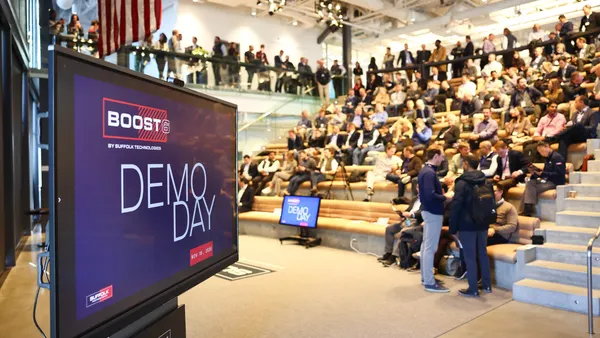While weighed down by a skilled labor shortage, the construction industry’s low productivity relative to other industries comes down to its fundamentally fragmented structure. Design hands off to engineering hands off to construction, and so on.
Chicago-based Skender looks to close the gaps and eliminate the inefficiency associated with each handoff through a vertical integration of design, engineering, manufacturing and construction. Technology, married to a lean approach, factors heavily in the firm’s ultimate goal of productization of buildings, CEO Mark Skender told Construction Dive. He compares his thinking to the way Toyota, which revolutionized lean manufacturing, views every iteration of its cars as an opportunity to optimize its manufacturing processes, and by doing so, deliver a higher-quality product and improve profit margins.
Skender brought Stacy Scopano on board this month as chief technology officer. Formerly Skanska USA’s vice president of innovation, Scopano will help steer the firm toward the technologies that will make it most efficient, particularly in its advanced manufacturing operations at a recently opened plant in southwestern Chicago.
“There’s a lot of opportunity here to look at the efficiency of how we implement the big-ticket technology trends” like BIM coordination and supply chain tracking, he told Construction Dive, “as well as navigate … this explosion of incremental technologies driven by the startup landscape.” Echoing his comments at a conference last year, Scopano again insisted that ramping up technology use is no longer optional for construction companies in the current climate.
Virtual design and construction underlies operations at the Skender plant, which is developing modular components for a six-story, 110-unit multifamily building for Chicago’s West Loop as well as scalable, pre-designed three-flats, a common architectural type in the city.
A digital workflow affords the firm an uninterrupted data stream, from design to supply chain to end users, Mark Skender said. And with this vertical integration already in place, Scopano said he can “hit the ground running” to help enable better flow in decision-making.
Rethinking the design and engineering process, improving supply chain management and infusing technology and automation are some of the strategies that firms can take, according to McKinsey, to boost productivity by 50% to 60%.
Skender believes that the more it can pull its operations into a controlled factory setting, the more productivity it can unlock. Affordability and repeatability are the immediate benefits for the firm, Scopano said, as it targets redundancies and asset classes like affordable housing that demand broad-scale solutions. With a high-quality product platform in place, he continued, Skender can retain these benefits while ramping up customization options for end users. Its three-flats, for example, will include several facade options.
With regard to the worker experience, by moving offsite, “we intrinsically change the safety dynamic in the industry,” Scopano said. Plus, operations are “stitched together into a different employee experience,” he added, where the meeting of technology and the built world appeals to new talent pools and presents a more sophisticated industry picture.
And whatever economic storms may come, a modular approach allows Skender to “pivot towards what’s hot, what’s not,” Scopano said, as rising demand in some markets supplants cooling demand in others. “We’re using the same … facility, the same processes and 80% of the same design, and we’re just fine-tuning and adjusting rather than turning off and turning on.”













